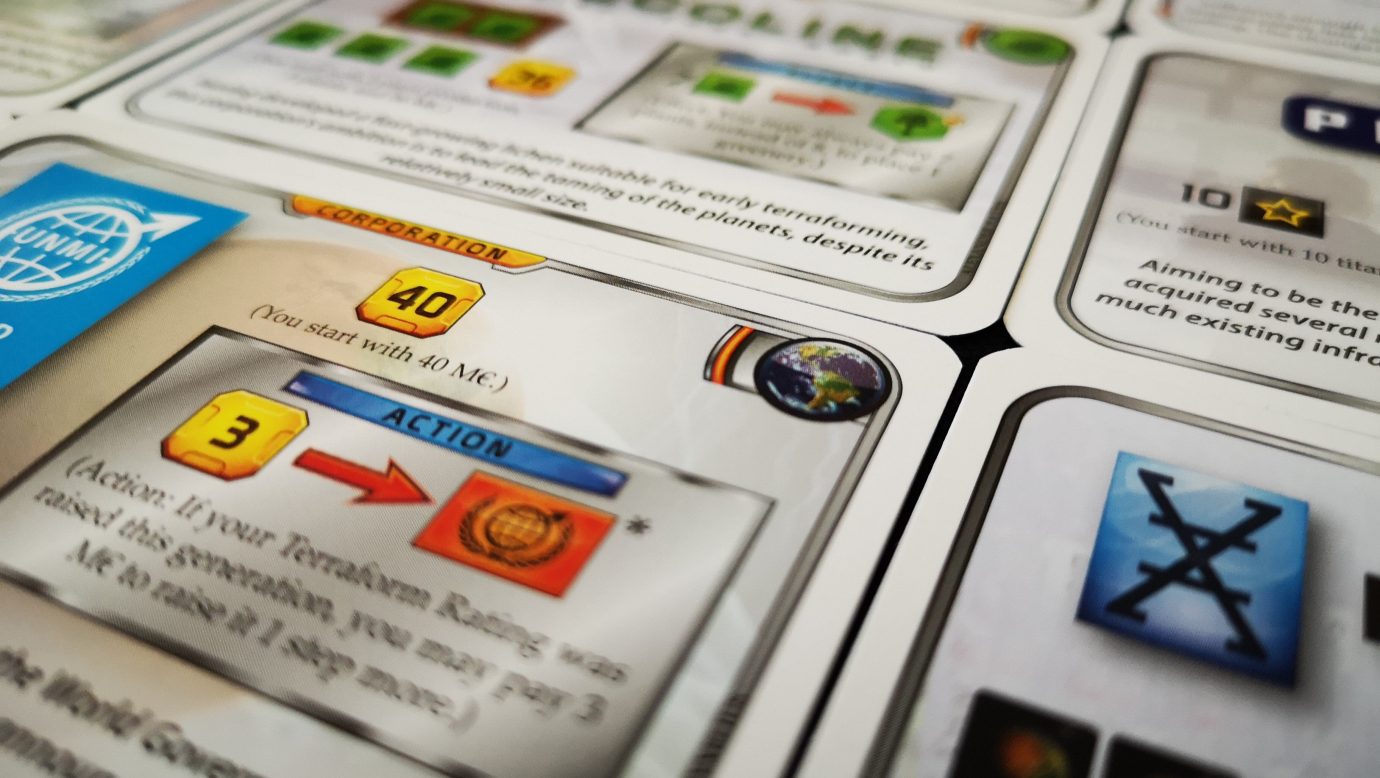Table of Contents
| Game Details | |
|---|---|
| Name | Terraforming Mars (2016) |
| Review | Meeple Like Us |
| Complexity | Medium [3.26] |
| BGG Rank | 7 [8.36] |
| Player Count (recommended) | 1-5 (1-4) |
| Designer(s) | Jacob Fryxelius |
| Buy it! | Amazon Link |
A review copy of Terraforming Mars was provided by Asmodee UK in exchange for a fair and honest review
Version Reviewed
English first edition, second printing
Introduction
You know how in the review I complained a bit about component quality, remarking that it has a noticeably negative impact on the immersion you might otherwise experience? Well, expect that theme to be repeated a fair bit here. It’s not often I call a board game one of the seven words you can’t say on television. Terraforming Mars has been the target of at least five of them. It’s still a great game – four stars worth of great if you take our opinion seriously – but the cheap components and ridiculous player boards are a genuine, honest-to-goodness drag on the fun you’re going to have.
Strap in, I’ve already aimed this rocket at the target area and blast off is in three… two… one…
Colour Blindness
The translucent cubes that make up the player ownership marker are technically possible to tell apart, with Tritanopes having the most significant difficulty when it comes to blues and greens. However, that’s only true really when you look at them in isolation.

When you have a whole board full of cubes, the situation becomes very problematic – especially given the lighting problems that translucency tends to exacerbate. Take a look for example at this top down view – adjacency effects are often important here, and every category of colour blindness is going to struggle at times. Consider for example Protanopes trying to differentiate green from yellow:

And Deuteranopes trying to tell green from grey:
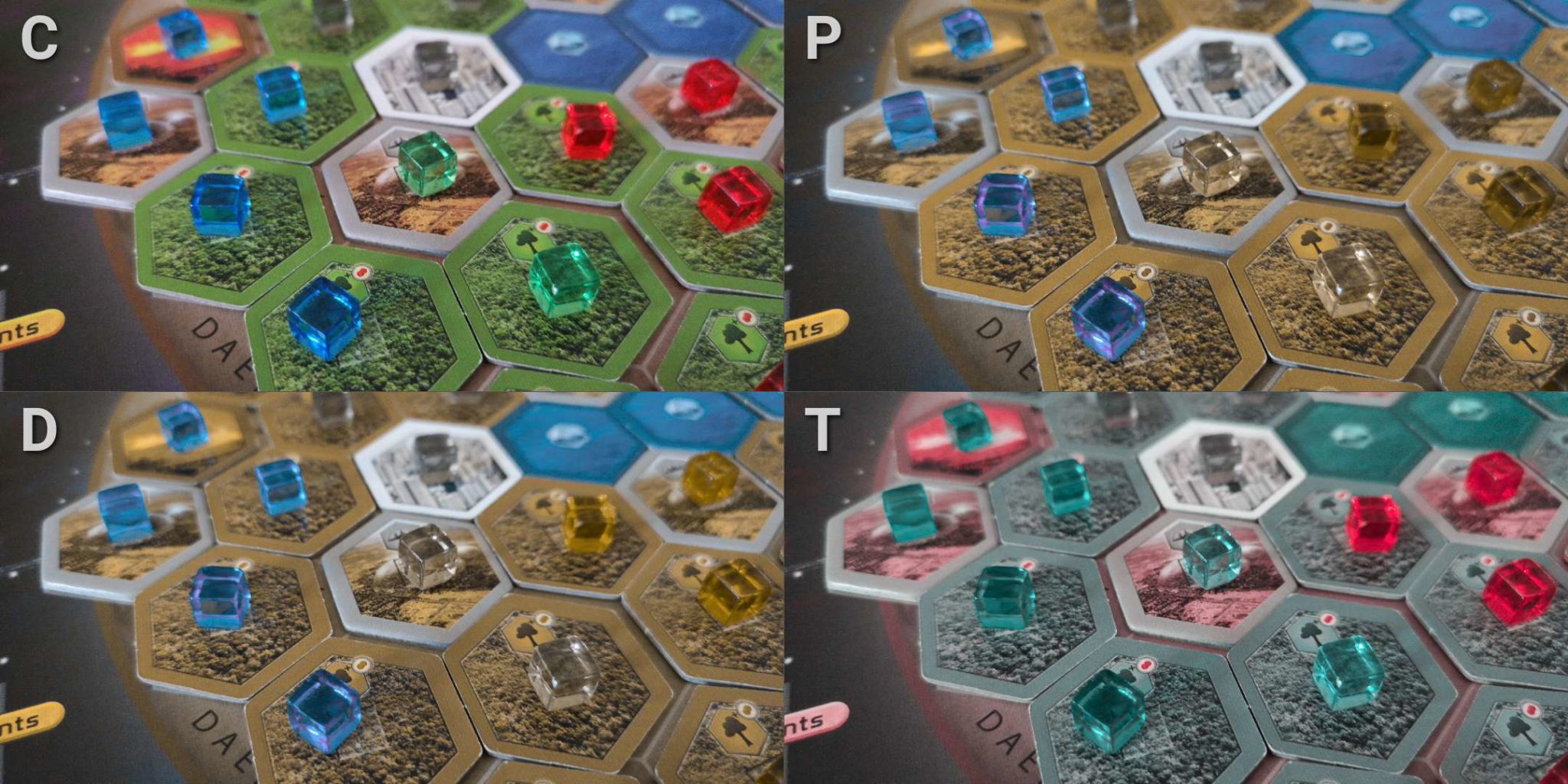
The cards at least are reasonably easy to work with, coming as they do with full text descriptions and alternating layouts that separate actions from events and events from other projects. The player boards too are fine, because while you use coloured cubes to mark resource production they’ll always be in front of the player for whom they are relevant.

It’s possible to play lots of Terraforming Mars without worrying about who owns specific tiles on the boards, but in the circumstances where that matters it will be a problem. The problem gets bigger the more people that are playing and the more different kinds of colour blindness that are in effect. You could though substitute some other kind of token to indicate ownership but you’d need a lot of them.
We’ll very tentatively recommend Terraforming Mars in this category – the colours chosen are a major problem but they are not the kind of persistent problem that makes the game unplayable. Compensations are inconvenient but possible. They just shouldn’t be necessary.
Visual Accessibility
There is a lot of game state in Terraforming Mars and none of it is really safe to ignore. You need to know about not only your own tableau, but also that of other players. You need to know what capabilities they have and how their actions will permit them to gain points later on. If you know someone has access to the Security Fleet card (permits a player to convert a point of titanium into a fighter resource) you’re going to be hesitant about leaving too much titanium on the board. If someone is controlling the Mining Guild corporation you’ll want to stop them building on steel and titanium resources as far as is possible. If you can steal a point of plant production from a player, you’ll probably want it to be one that can most efficiently convert plants into points. Some of that is inherent to the corporation they play but every player will be building a sophisticated engine of cards in front of them and you need to know what it can do.
That’s complicated by the cards themselves, which are very information dense. Consider the four cards below:

Note that they all have different combinations of tags, pre-requisites, victory points, costs and productions. The mass converter for example requires five science tags to be in your tableau before it can be played. The Space Station has no production. Shuttles have pre-requisites, production and victory points. These are consistently located although inconsistently visible for the most part. https://amzn.to/2Tad5rnThere are variations though. Consider where the production box is on the Hackers versus the Shuttles, as an example.

Part of the problem for a visually impaired player is going to be in the system of interlinking tags. The mass converter as mentioned requires five science tags to be in play, and that means checking what might be dozens of cards for icons that may be in slightly different locations depending on tag ordering. There may be several cards in a round that have tag-related impact, and others that have impact based on board state. ‘Raise megacredit production by one for each city on the board’ for example. Cards also tend to be wordy containing flavour quotations as well as textual descriptions of what the icons do.

There are a number of special tiles that are placed on the board based on card play, and these all have the same basic form of being brown with a tiny icon. However, they may have complex scoring requirements associated with them – the economic zone for example gains a point for each adjacent city. Knowing which indistinguishable brown tile is which is going to be important, at least in tightly matched games.

Player boards are a massive problem for several reasons:
- They are shockingly flimsy. Mine developed a bend that could comfortably fit a cube after only a couple of games.
- They are extremely low friction. You will be placing, and occasionally absolutely heaping, very low friction cubes on these very low friction ‘boards’.
- They are very tightly constrained, and it’s easy to knock cubes from one location to another with significant game effect.
The player board is theoretically amenable to physical querying but seriously – a sneeze can result in cubes moving from one place to another. I dread to think what would happen if someone seriously tried to work out the game state on the basis of what their fingers found. It’d be the equivalent of feeling to see if the grass was wet and somehow finding ten million pounds in your bank account.

Seeing opportunities for synergistic play is also going to be important, and you rapidly build up a very large tableau of cards that consist of special actions only you can take. These exist alongside an accumulating legacy of one-off projects that continue to have an impact through the course of play as a consequence of their tags. More than this, some of the cards you can play depend on tags other players have. Working out your best opportunities depends on seeing how the various parts of your engine interlock – memorising what things do is complicated by the fact that some of this is contingent on some reasonably complex chains of effect.
We don’t recommend Terraforming Mars in this category but it is likely playable with considerable table support.
Cognitive Accessibility
There’s no getting away from the fact this is a complicated game and it puts stresses on all cognitive faculties. It’s very strongly driven by synergies, for example. Those synergies are often sequence dependent – the order in which you play cards is going to be hugely significant. It might be the difference between getting one point for an action and getting five. A lot of what you’re doing is looking to leverage opportunities to accomplish goals at the end of a cause and effect chain. Sometimes that gets actioned within a particular generation, and sometimes it’s part of a long-term plan. You might for example have a corporation that gives additional steel or titanium and seek to build something like this:
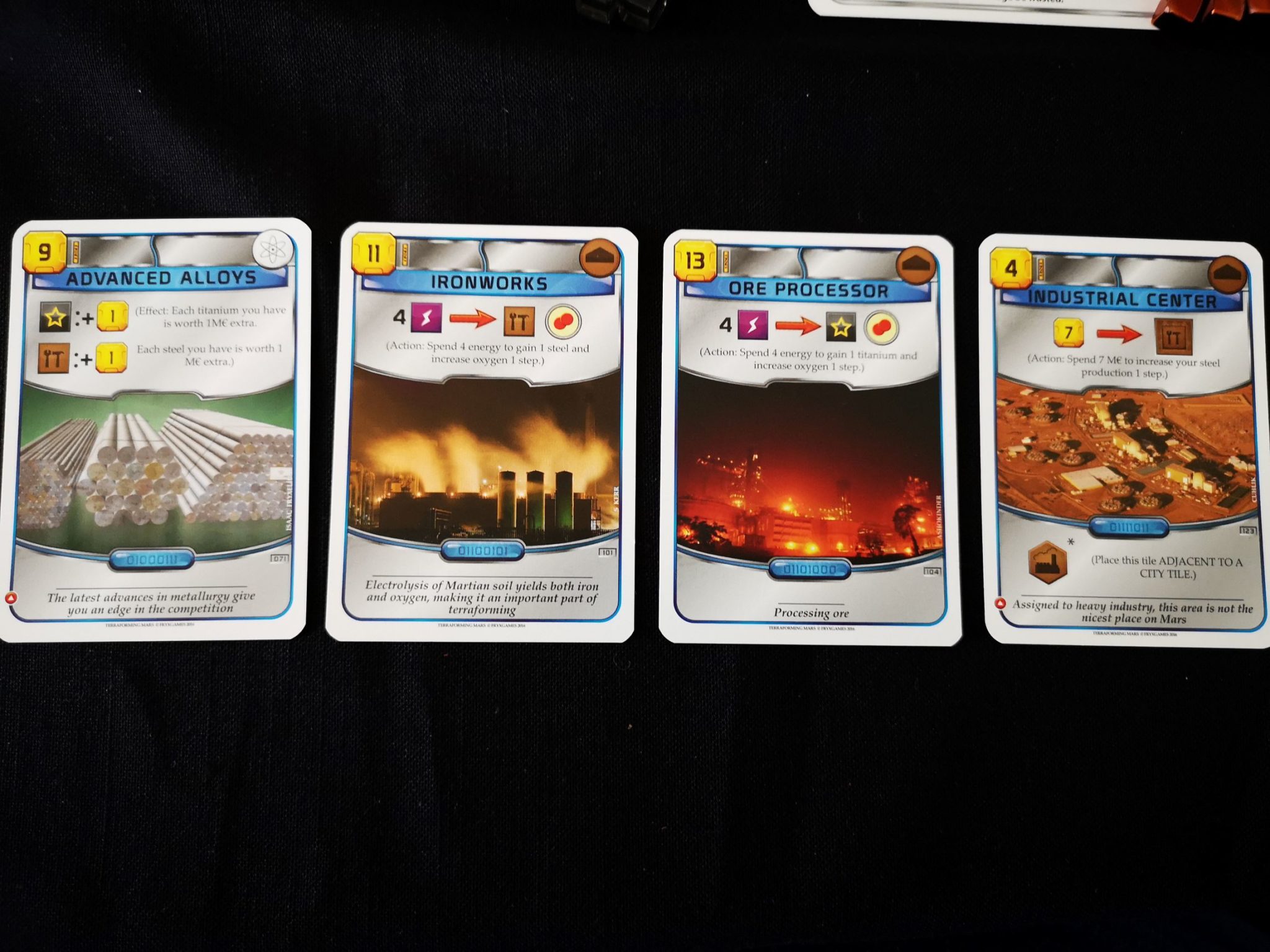
To take advantage of this engine, you might play special events to ensure that you get lots of energy so you can keep ramping up steel and titanium production. Steel can be used for building cards and titanium can be used for space cards, so that in turn creates a great subsidy for a particular approach to point generation. That needs long term planning and a willingness to pick up cards in the short term that are only going to reach their full value later. It needs you to engineer a lot of things to bring life to this flow of power and also take advantage of the increased production. If any part of this doesn’t fall into place, you can do yourself an injury when it comes to effective play.
More short-term chains of cause and effect on the other hand might look like this:

By arranging this you can use the symbiotic fungus to add a microbe to the Tardigrades card; the extreme cold fungus to add two microbes to the Tardigrades; and the Tardigrades card itself to add one microbe to the card. Every four microbes earns you a victory point so this chain basically ensures a point every generation. However, given the terraforming requirements on these cards you need to do a fair bit of work to get them all lined up at the right time. Especially if you want to still benefit from their existence long enough to justify the opportunity cost that went into their collection.

When it comes to the more straightforward aspects of laying down tiles, it’s important to consider adjacency effects and placement rules. You don’t want to surround a city with forest tiles if you’re going to end up giving more points to everyone else than you gain. Similarly with the awards and milestones that award points to players for their accomplishments – sometimes with your actions you might find yourself enabling other people by subsidising the cost of their developments.
Literacy requirements are very high, and numeracy requirements are significant if you want to have a handle on how you’re doing in the game. A city is worth a point for every piece of adjacent greenery, and each tile of greenery is worth a point to its owner. Everyone is going to have their own blend of these and the value of placing a tile depends on a calculation of future points values. As an example you want cities to be where other people are incentivised to grow forests. With this and the various chain effects of the cards this leads to an intensely complicated game state.
For those with memory impairments only the story is slightly more positive. Everything you need is explicitly represented on the board except for that which is in the hidden deck of cards. Knowing deck composition is hugely valuable, but it’s not necessarily mandatory in order to play well. You can roll with the cards, but knowing which cards might be coming is useful. Other than this the main memory burden is on simply keeping track of which actions are available on a turn and what resources you need in order to take advantage of their presence. Oh, and also remembering what your production levels are since they are going to get upset during the course of the game and there’s no obvious way to rebuild a player board unless you remember what its values should be.
We can’t at all recommend Terraforming Mars for those with fluid intelligence impairments. We don’t recommend it for people with memory impairments because of the game’s complexity but we concede that it is likely playable with support and prompting from the table.
Physical Accessibility
Almost nothing about Terraforming Mars is good here. At best I can say is that the board contains numerous landmarks that ease verbalisation, but they’ll get covered up during the course of the game.
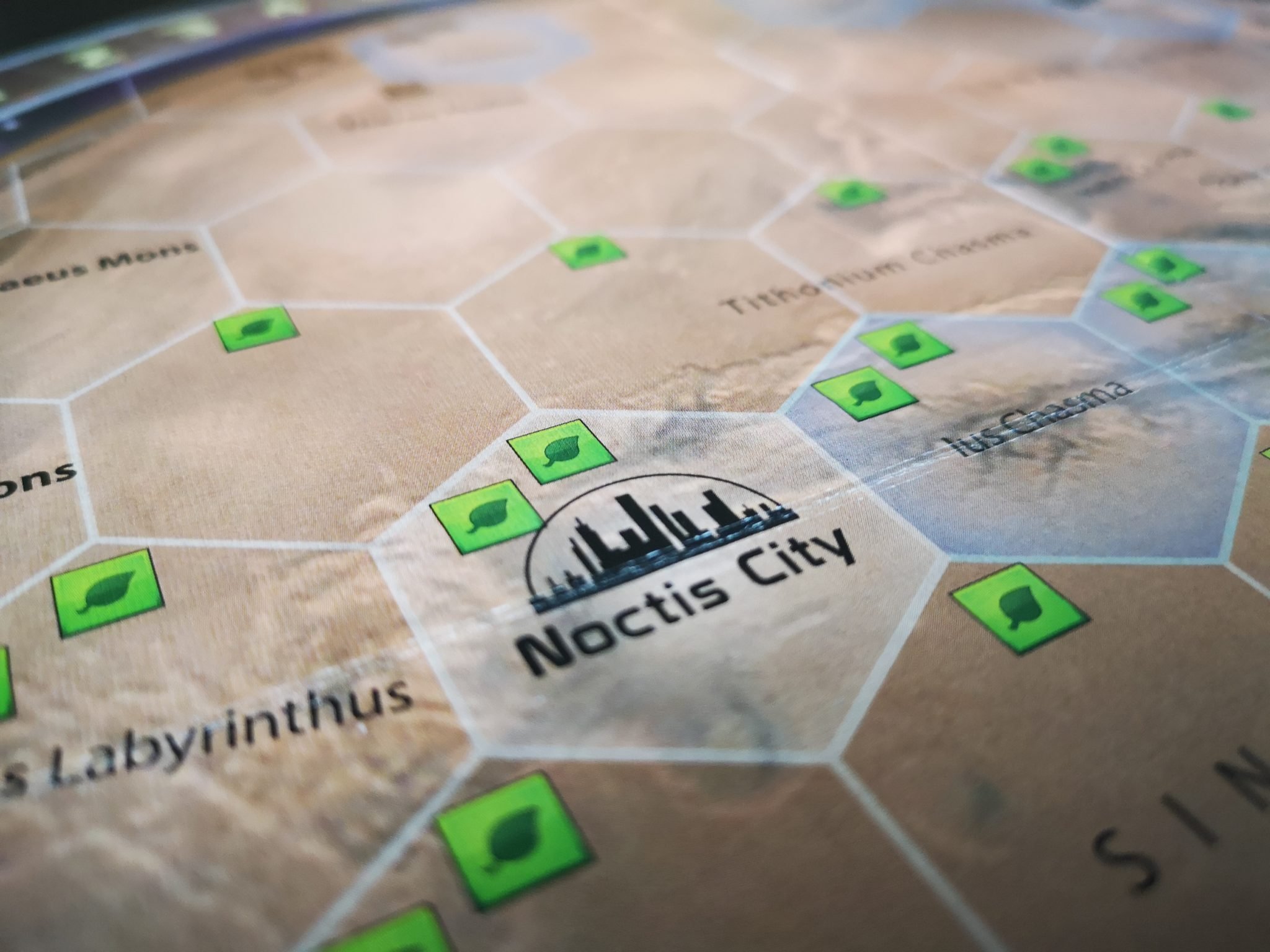
If player agency in board interaction is important, Terraforming Mars is a uniquely poor game from a physical accessibility perspective. The cubes you work with are very low friction and are easily dropped – and you’ll be dealing with many of them at a time. Your player board is ridiculously flimsy and when you drop cubes on it they’ll cascade everywhere. You need to carefully position cubes on the board to stop that happening but that’s a problem too because it’s in two rows of resources and you need to make sure even a loose sleeve doesn’t brush against anything. The main Mars board is tightly constrained and often you’ll be placing tiles in amongst other tiles. Since they’re hexes it’s not always possible to simply slide them in.
You will have a hidden hand of cards, and that hand has no upper limit. The number of cards you have is even important for some game elements. One of the milestones in the game for example is for having sixteen of these in hand at any one time and that is worth five points. That’s a lot of points in Terraforming Mars. The cards are information dense and don’t compress at all in a card holder. You need to see both top corners, and often the main body of the card is full of important information
The tableau you build during play will rapidly become overwhelming, with some cards having resource cubes as well as player cubes to indicate that they’ve been used. As with the boards, it’s easy for someone to upset this delicate balance of cubes and card and effectively shuffle your game state.
If someone is acting on behalf of another player, it doesn’t get much better. Simply leaning over to adjust someone’s player board is a risky manoeuvre since, as previously mentioned, it’s incredibly easy to upset the state of the game. Often when playing I have found a rogue cube that once indicated my plant production and been forced to simply guess at where it was. You can play with alternate components here, but they’re going to introduce their own difficulties because of the way in which cubes are logically malleable. You might use casino chips for example, but while they would work for representing money it might not work so well for microbes stored on a card if you also want to be able to read anything on it. There are digital tools available, but our reviews work on the assumption, for the most part, that you’re playing the game as it comes out of the box.
We don’t at all recommend Terraforming Mars in this category.
Emotional Accessibility
There are some explicitly aggressive events in Terraforming Mars, where a player is empowered to remove resources and sometimes even production from another player. These are pointedly targeted, but this is mitigated sometimes by those occasions where the person selected is really the only valid target available. Other than this, I think the largest emotional accessibility problem lies in the randomness of the game and how that intersects with the end-state of play.
Imagine you’ve got a functioning engine for the game – you’re earning points and you think you’re going to win if only you can get your plant production up so as to let you more effectively plant greenery tiles. Imagine another player who is currently behind but just played down the Space Fleet and the Physics Complex. Every generation they get three points in addition to anything else they manage. Over the course of the next five or six generations they’ll probably overtake you, but as long as you can plant enough trees to hit the oxygen target and end the game you’ll be fine.
Now imagine that second player does everything they can to stop that happening. They play an asteroid that wipes out your plant reserves. They play another card that removes a point of plant production from you. They play down a city purely to make sure that when you do finally manage to play down a greenery tile it does them as much good as it does you. Essentially, they act like a recalcitrant child grabbing hold of a parent’s ankles on a boring shopping trip. Their job is to slow you down long enough until they win.
Bad enough, but now imagine every card you draw is useless to you and you have no mechanisms by which you can get better cards. You draw cards that convert your plant production into heat, and your plant reserves into money. Neither are any good to you, but it’s all you have to work with. There are cards in the deck that would end the game with the effectiveness of a sword-thrust but simply top-decking until you find them is frustrating. That’s made more so by someone actively trying to drag the game out longer than they should just so they win by the gradual accumulation of points. Worse, if other players in the game see this happening they might very well turtle around their own point generation engines dragging the game out even longer.
The incentives of any one player don’t necessarily work to bring the game to a conclusion and this can result in long play sessions where someone takes too much time to work through all their actions just to keep the game where it was. This can in turn lead to very significant score disparities because playing to win the game is not necessarily the way to win.
Other than this there are few worries in this section. The game is challenging but fair, players are never eliminated from the game, and while it’s possible to gang up on a player it’s difficult to see why it’s something a table would want to do. We’ll tentatively recommend Terraforming Mars in this category.
Socioeconomic Accessibility
The manual explains the rules in a second person perspective, and there’s no use of gender specific language. I also really like how it includes scientific notes in the text, but that’s neither here nor there. It’s just something that I wanted to mention and I’d like more games to do it so it feels like I’m genuinely learning instead of wasting my life critiquing board games. Only a few of the cards show any identifiable people, and while there is a blend of genders and ethnicities it does skew very heavily towards white men. There are a lot more people in spacesuits, but it’s hard to tell what’s going on under them.
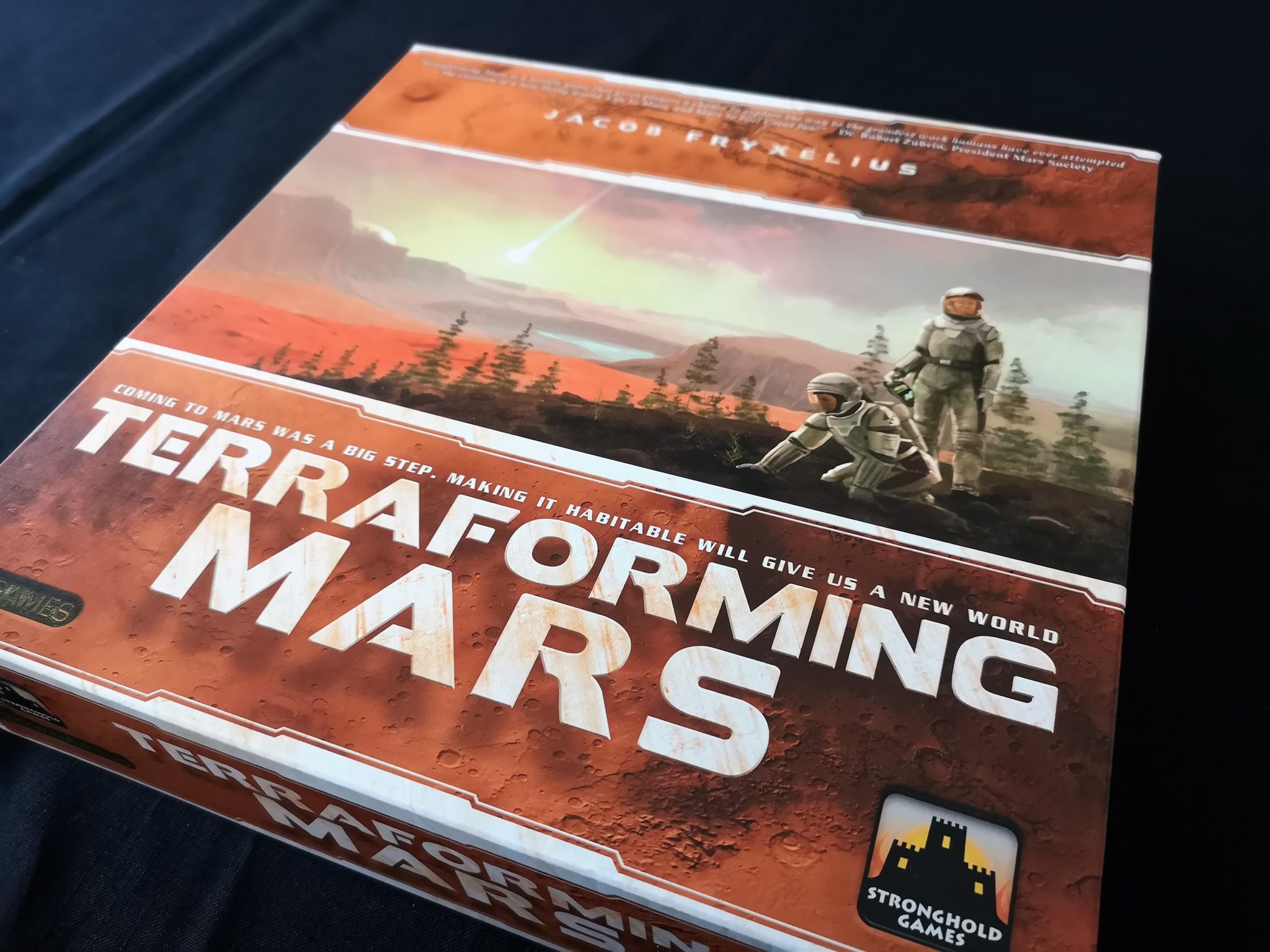
Terraforming Mars has an RRP of approximately £50 and whether that represents good value depends on how much you’re going to get hung up on the component quality. It’s obviously been a big feature of this teardown, but it has to be weighed up against just how much you get in the box. You get a huge deck of cards, and a huge pile of resource cubes. And even more cubes for players. I’d have been happy to pay a little more to have player boards that were actually useful but I’m an over-privileged asshole and it’s easy for me to say that. It genuinely is a very good game, and it supports a good solo mode and a maximum of five players. You’ll definitely get your money’s worth even if you might wish that money had been spent slightly differently in the way the components are presented.
We’ll recommend Terraforming Mars in this category.
Communication
There’s no formal need for communication during the game, but the literacy requirements are very high. To be fair, it also provides card effects in an iconographic language. That though puts a fair learning curve in the way before play would be smooth enough to progress without the textual instruction. We’ll recommend Terraforming Mars in this category, but only just.
Intersectional Accessibility
Given our negative recommendations in most of our categories, there aren’t a lot of intersectional issues to discuss here. Every significant intersection is already handled by one or t’other of the recommendations. I would say that the issue of the player boards is aggravating and if emotional considerations intersect with any others, it might be sufficient to nudge the game out of accessibility.
Terraforming Mars is a long game that can become longer depending on how people are focusing play. It’s a game that needs people to work towards the end goal but doesn’t necessarily make it worth their while. It’s also a game that tends to slow down as the generations progress and more actions and concerns fill up your thinking time. It’s easily long enough to exacerbate issues of discomfort or distress although it’s also a game that can reasonably easily support players dropping out. They just stop contributing to the development of the planet. That might be necessary, especially if players have attention problems, because you’ll spend a lot of time staring at the board with nothing to do as the final generations play themselves out.
Conclusion
It’s not a surprising profile, but that doesn’t mean I’m happy to see it – I always prefer great games are accessible. Part of the problem here with Terraforming Mars is that we can easily see a more accessible game if some other decisions were taken with the game production.
It’s probably a write-off from a cognitive accessibility perspective but better player boards would have done wonders for the physical accessibility section and would have improved the grade for those with visual impairments. Better choice of colours for player cubes would have fixed the colour blindness section. It could have done noticeably better without anything in the game changing.
We gave Terraforming Mars four stars in our review – it’s a genuinely great game and I have played it dozens and dozens of times. It’s a shame really that such a well designed and well-regarded game should be let down so by its component design. Perhaps should we see a second edition of the game we’ll be able to revisit the Red Planet with a more positive outlook.
A review copy of Terraforming Mars was provided by Asmodee UK in exchange for a fair and honest review
A Disclaimer About Teardowns
Meeple Like Us is engaged in mapping out the accessibility landscape of tabletop games. Teardowns like this are data points. Games are not necessarily bad if they are scored poorly in any given section. They are not necessarily good if they score highly. The rating of a game in terms of its accessibility is not an indication as to its quality as a recreational product. These teardowns though however allow those with physical, cognitive and visual accessibility impairments to make an informed decision as to their ability to play.
Not all sections of this document will be relevant to every person. We consider matters of diversity, representation and inclusion to be important accessibility issues. If this offends you, then this will not be the blog for you. We will not debate with anyone whether these issues are worthy of discussion. You can check out our common response to common objections.
Teardowns are provided under a CC-BY 4.0 license. However, recommendation grades in teardowns are usually subjective and based primarily on heuristic analysis rather than embodied experience. No guarantee is made as to their correctness. Bear that in mind if adopting them.
